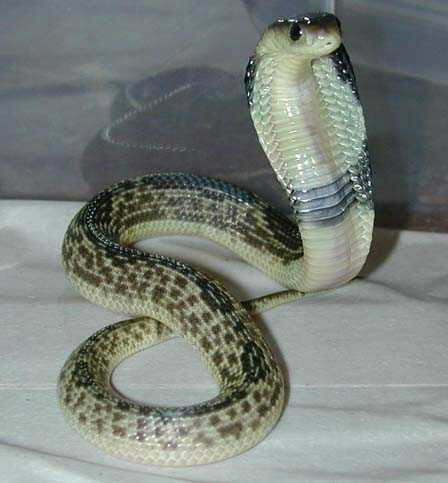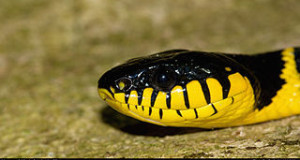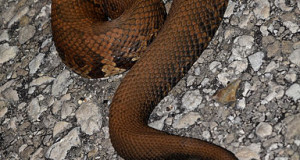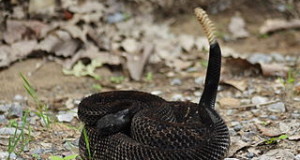Working with Spitting Cobras has been a fascinating, if sometimes un-nerving, experience. In addition to being able to deliver venom via biting or ejection through the air, Spitting Cobras also have the alertness and speed that is typical of nearly all the world’s 353 Elapid species. On two occasions, I’ve had to re-capture a total of 6 escaped Red Spitting Cobras (Naja pallida) – once because a man helped his little son to kick in the glass of an exhibit at the Bronx Zoo! (please see article linked below) But despite these incidents, and decades of working closely with related species, the only venom to wind up in my eyes came not from a Spitter, but rather courtesy of a species that “cannot spit” – the Western Diamondback Rattlesnake (Crotalus atrox).
Illegal Rattlesnakes: Live and Cooked
Most of the obvious risks associated with venomous snake care are easy to avoid (in a reputable zoo, that is…one cannot properly prepare for a bite delivered by a snake in a private collection). When working with Spitting Cobras, for example, safety glasses are always worn. Emergencies occur, of course, and then you must sometimes make do without. In the escape mentioned earlier, for example, I arrived on the scene not knowing that Red Spitting Cobras were involved, and I had to immediately evacuate visitors, many of whom were children, from the area.
But, as in most fields, the greatest dangers arise from unexpected situations – those that we don’t imagine or believe can happen. This was the case one day when I was in a Bronx Zoo holding area, checking on some newly-arrived Western Diamondback Rattlesnakes. The snakes had been confiscated the night before, in a store in NYC, of all places. Several police officers had entered following a report of a burglary, and found snakes instead of criminals. The snakes, mainly Western Diamondbacks, were being held in a variety of slip-shod containers; several dead individuals were in cooking pots, alcoholic drinks, and “medicines”. As usual, the Bronx Zoo was summoned.
“Hey…Rattlesnakes Can’t Spit”
Co-workers and I had installed the snakes in screen-topped aquariums in an isolation room at the zoo’s Reptile House. As is dictated by protocol (and common sense!), I was careful not to lean on any screen tops as I checked the animals. All were highly agitated. Unable to see one individual clearly through the tank’s glass side, I peered down into the screen top. The snake struck at the top, and I instantly felt a splash of liquid in both eyes.
The standard wisdom is that only Spitting Cobra venom can cause eye damage. In the rare event that another type of venom enters the eye, it needs merely to be washed out; a follow-up with a doctor, to assure that an infection does not take hold, should follow. But this incident was unique for two reasons. First, the force of the snake’s strike against the screening had propelled the venom into my eyes. Second, I had just returned to work following a cornea transplant. There were numerous stitches in my eye, and they were not all that stable.
I felt a stinging sensation (which is not typical for other than Spitting Cobra venom) and thought that perhaps the venom had seeped under my cornea through the stitches. I wondered if the transplant could be ruined, and if I might suffer a typical envenomation as well, once the venom moved further along in my body.
Just When You Thought You Had Seen Everything…
The Bronx Zoo’s snakebite protocol relies upon the NYC Police Department for transport to the hospital. Fortunately, several NYPD Officers are always on the grounds. I was on friendly terms with all – one, in fact, was a former BZ animal keeper, and all were top-notch. It’s hard to surprise an officer who’s spent some time in the Bronx, but I did a good job that day! In less time than I could imagine, I was at Jacobi Hospital being attended to by a young doctor who, after some time in a busy Bronx emergency room, thought he had seen it all!
All went smoothly, and I suffered no symptoms of envenomation. It would have been interesting to learn if the venom had entered my body via a cornea stitch, but in those years Bronx hospitals were unbelievably busy (often with unbelievable, at least to me, cases) and there was no time for speculation or experimentation – I was shuttled out as quickly as I’d arrived!
Further Reading
A Close Call with a King Cobra
 That Reptile Blog – Reptile, Amphibian and Exotic Pet Care and Information
That Reptile Blog – Reptile, Amphibian and Exotic Pet Care and Information







“Most of the obvious risks associated with venomous snake care are easy to avoid (in a reputable zoo, that is…one cannot properly prepare for a bite delivered by a snake in a private collection).” Frank, let me begin by saying you have my highest respect regarding keeping reptiles and any animal for that matter. I disagree however with the above quote. Specifically where you say and I’m paraphrasing that someone cannot properly prepare for a bite in a private collection. I don’t feel that’s an accurate statement as there are numerous people who keep venomous animals in private collections and have protocols on hand to insure their safety.
Would you elaborate on this statement please? The way I read this is that private keepers of venomous snakes are incapable of preparing protocols and or measures to insure their safety. This is simply not the case as I’m sure you would agree we’ve both seen personally and know of many private keeper collections wherein there are protocols and the captive care is of the utmost quality. I’ve even written a short piece on keeping venomous animals (not just reptiles) in the captive environment in the booklet Venom in Captivity which has been reviewed and given quite excellent reviews from noted private venomous keepers and others as well.
Again please don’t take this as combative to your statement but more as a professional discussion for clarification. I look forward to speaking with you.
Hello John,
Thanks for your interest. I’ve been in charge of the Bronx Zoo’s protocol at various points in my career, set up the current protocol for the Staten Island Zoo and have consulted with others. I’ve responded to dozens of venomous bites to private keepers, and was made aware, in the course of my work, of most others that occurred in the USA for a period of nearly 30 years. Several hundred in all; almost all to private keepers, despite the fact that zookeepers handle hundreds of individuals weekly in most cases. Several bites were to extremely wealthy (even by Manhattan standards) owners, well able to prepare. Some had reasonably well-researched protocols, but I’ve not seen any situations where such owners were properly prepared. The same holds true for colleagues across the USA and, as far as I know, in other countries as well. Having a protocol is only the first step…not useful if it cannot be implemented fully.
I’ll summarize here…a proper protocol is quite an extensive document, and includes additional info re antivenin supplies etc. Alarms are at each cage, and other staffers, trained to contain an escaped snake (or dispatch it if necessary) and to initiate treatment (not antivenin administration…that can only be done in a hospital due to risks of life-threatening reactions to horse serum etc) are always at hand. If a second person is not in the building, cages containing venomous snakes are not opened, no matter what the snake’s needs may be. Alarms alert security dept to summon NYPD – ambulances have been tested, etc…NYPD response time is better, officers are made familiar, etc. The hospital to which victims (actually, there’s never been a bite in the Bx Zoos 100+ year history) are taken has on staff doctors trained in this area, along with the acknowledged expert in this part of the country. Antivenin is kept on site (zoo), as doctors may not be able to ID snakes, etc. Adequate amounts for several serious bites by each species in the collection are on hand. Huge amounts may be needed, and due to venom evolution, individual reactions etc, it’s difficult to predict exact needs. Therefore, back-up supplies of all, in other zoos, are also available, and protocols for delivering such via helicopter are established. keeping track of antivenin, and assuring expired supplies are replaced (at zoo and in back-up zoos) is a major headache…importing is especially difficult, and supplies can be unexpectedly cut-off for long periods of time for many reasons. Security (cage security, back-up/service area and building security) are monitored; supervisory personnel review continually so that mistakes do not go unnoticed. Research re venom evolution is extremely important…one staff member spends a significant portion of her/his time on this, and the curator as well; actual treatment protocol for individual species must change in order to accommodate this…in some cases, what works in one portion of a species range may be useless in another (see here: http://blogs.thatpetplace.com/thatreptileblog/2014/03/03/most-dangerous-snake-in-usa-rattlesnake-study-provides-clue/#.VG0cVclDV30)
There’s more, but that should provide a general sense of what’s involved. In any event, the issue will likely be moot, at least in the USA, in the not too distant future. As an attorney, I’ve been involved in the legalities of this area…most states will outlaw the keeping of venomous snakes in time.
Over the past 40 years or so I’ve come to realize that, for whatever reason, I’ve been able to change the minds of very few venomous snake keepers…until a bite occurs! At that point, resistance to the directives of those responding evaporates, and folks generally emerge from the experience (survivors, that is) with a very different perspective. I’m not foolish enough to claim that I’ve heard all the arguments in favor of keeping venomous snakes in homes, but I have heard and responded to all of the standard ones, and I have no interest at all in debating the right of governments to regulate this or that (this issue almost always arises). I realize that opinions are very strong among venomous keepers..I’ve gone into this at greater length on other sites, but have had to drop out of the discussions as the same ground was covered time and time again, to no avail, as far as I could see. Sorry I could not provide a more supportive response, but I’ve seen too many sad and tragic situations that could have been avoided – yes, some involved the typical “surface-macho” silliness, but bright, mature individuals with unlimited resources have also been affected. Keep up your good work, I enjoy… best, Frank
Frank, I have to say again I respect your position and appreciate the insights and the same insights have been offered by other colleagues whom I also respect very much. Even though I don’t particularly want to agree with you, your evidence is just that. Hard cold facts that show us otherwise. Thanks again for taking the time to respond and I’m very happy we could discuss this as professionals. As you said we’ve both seen these discussions turn into something they don’t need to. I will say I wish that keepers be they venomous private keepers or otherwise were much more responsible than what we’ve seen. As the old saying goes, one bad apple ruins the bushel.
Hello John,
I greatly appreciate your being so gracious in your reply, thanks very much. I was going to email you privately to make sure you understood that I was not trying to be harsh in my response. I look forward to reading your articles and to other discussions. best regards, Frank
Hello,
I have been an avid follower of your posts on this blog for quite some time now. You are an excellent writer and I love vicariously living through your adventures. I was wondering if you could take the time to write an article on crested geckos as it seems to me that nowadays, this species is giving the leopard gecko a run for its money in case of most popular, easiest to care for, beginner lizard. Just a suggestion as I know I and many other readers would greatly appreciate it.
Hello malik,
Thanks very much for the kind words!
An excellent suggestion, thank you. I’ll try to schedule an article in the near future.
Best regards, Frank
Hello,
I have been a venomous snake keeper for over 10 years and I am bite survivor.
I read Frank’s articles regularly and have had discussions with him about keeping venomous snakes by private keepers. I obviously do not agree with him in this issue but I still respect him for his opinion as it is the result of tremendous experience.
Keeping venomous snakes is a personal choice and especially in countries where proper regulations exist, it is a safe, rewarding hobby. But I have to stress over and over again that proper smart regulation by a knowledgeable government entity is the key here and without it’s existence, I would be on the same page with Frank when it comes to private keepers. A 16 year old kid with no venomous experience and no emergency protocol buying a cobra on impulse is a nightmare for a proper venomous keeper as bad publicity will kill our hobby.
Cheers,
Yasin
Hello,
Thanks for the interest and kind words, much appreciated.
Here in the USA, the personal choice aspect will become moot over time; as an attorney, I’ve worked on the legal aspects of this situation, and stay in touch with developments; most states will outlaw venomous snake ownership in time.
Protocols are necessary, of course, but they must be able to be fully implemented. In the USA, that is not possible due to problems involved in training (owner and the necessary others to have on hand each time a cage is opened), emergency responder availability/coordination and, especially., antivenin availability.
Following is a response I posted re this earlier; it provides just an overview of the propotocls and safeguards in place at US AZA affiliated zoos. It is not possible for a private individual, in the USA, to duplicate this; colleagues in other countries assure me that this holds true elsewhere as well, but I have direst experience in only 2-3 other countries. Best, Frank
I’ve been in charge of the Bronx Zoo’s protocol at various points in my career, set up the current protocol for the Staten Island Zoo and have consulted with others. I’ve responded to dozens of venomous bites to private keepers, and was made aware, in the course of my work, of most others that occurred in the USA for a period of nearly 30 years. Several hundred in all; almost all to private keepers, despite the fact that zookeepers handle hundreds of individuals weekly in most cases. Several bites were to extremely wealthy (even by Manhattan standards) owners, well able to prepare. Some had reasonably well-researched protocols, but I’ve not seen any situations where such owners were properly prepared. The same holds true for colleagues across the USA and, as far as I know, in other countries as well. Having a protocol is only the first step…not useful if it cannot be implemented fully.
I’ll summarize here…a proper protocol is quite an extensive document, and includes additional info re antivenin supplies etc. Alarms are at each cage, and other staffers, trained to contain an escaped snake (or dispatch it if necessary) and to initiate treatment (not antivenin administration…that can only be done in a hospital due to risks of life-threatening reactions to horse serum etc) are always at hand. If a second person is not in the building, cages containing venomous snakes are not opened, no matter what the snake’s needs may be. Alarms alert security dept to summon NYPD – ambulances have been tested, etc…NYPD response time is better, officers are made familiar, etc. The hospital to which victims (actually, there’s never been a bite in the Bx Zoos 100+ year history) are taken has on staff doctors trained in this area, along with the acknowledged expert in this part of the country. Antivenin is kept on site (zoo), as doctors may not be able to ID snakes, etc. Adequate amounts for several serious bites by each species in the collection are on hand. Huge amounts may be needed, and due to venom evolution, individual reactions etc, it’s difficult to predict exact needs. Therefore, back-up supplies of all, in other zoos, are also available, and protocols for delivering such via helicopter are established. keeping track of antivenin, and assuring expired supplies are replaced (at zoo and in back-up zoos) is a major headache…importing is especially difficult, and supplies can be unexpectedly cut-off for long periods of time for many reasons. Security (cage security, back-up/service area and building security) are monitored; supervisory personnel review continually so that mistakes do not go unnoticed. Research re venom evolution is extremely important…one staff member spends a significant portion of her/his time on this, and the curator as well; actual treatment protocol for individual species must change in order to accommodate this…in some cases, what works in one portion of a species range may be useless in another (see here: http://blogs.thatpetplace.com/thatreptileblog/2014/03/03/most-dangerous-snake-in-usa-rattlesnake-study-provides-clue/#.VG0cVclDV30)
There’s more, but that should provide a general sense of what’s involved. In any event, the issue will likely be moot, at least in the USA, in the not too distant future. As an attorney, I’ve been involved in the legalities of this area…most states will outlaw the keeping of venomous snakes in time.
Over the past 40 years or so I’ve come to realize that, for whatever reason, I’ve been able to change the minds of very few venomous snake keepers…until a bite occurs! At that point, resistance to the directives of those responding evaporates, and folks generally emerge from the experience (survivors, that is) with a very different perspective. I’m not foolish enough to claim that I’ve heard all the arguments in favor of keeping venomous snakes in homes, but I have heard and responded to all of the standard ones, and I have no interest at all in debating the right of governments to regulate this or that (this issue almost always arises). I realize that opinions are very strong among venomous keepers..I’ve gone into this at greater length on other sites, but have had to drop out of the discussions as the same ground was covered time and time again, to no avail, as far as I could see. Sorry I could not provide a more supportive response, but I’ve seen too many sad and tragic situations that could have been avoided – yes, some involved the typical “surface-macho” silliness, but bright, mature individuals with unlimited resources have also been affected.
An interesting read. I can certainly relate to the risks of housing the likes of rattlesnakes in mesh top enclosures. Around 20 years ago I witnessed one of our Western Diamondback Rattlesnakes (Crotalus atrox) hit the lid with sufficient force to expel venom and send it into my face. I did not get any venom in my eyes but it certainly served as a lesson as to the potential risks involved.
Regards,
Paul Rowley
Herpetologist
Alistair Ried Venom Research Unit
Liverpool School of Tropical Medicine
UK
Hello,
Thanks for the kind words and interest, best regards, Frank